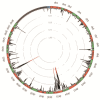ABCC transporters mediate insect resistance to multiple Bt toxins revealed by bulk segregant analysis
- PMID: 24912445
- PMCID: PMC4071345
- DOI: 10.1186/1741-7007-12-46
ABCC transporters mediate insect resistance to multiple Bt toxins revealed by bulk segregant analysis
Abstract
Background: Relatively recent evidence indicates that ABCC2 transporters play a main role in the mode of action of Bacillus thuringiensis (Bt) Cry1A-type proteins. Mapping of major Cry1A resistance genes has linked resistance to the ABCC2 locus in Heliothis virescens, Plutella xylostella, Trichoplusia ni and Bombyx mori, and mutations in this gene have been found in three of these Bt-resistant strains.
Results: We have used a colony of Spodoptera exigua (Xen-R) highly resistant to a Bt commercial bioinsecticide to identify regions in the S. exigua genome containing loci for major resistance genes by using bulk segregant analysis (BSA). Results reveal a region containing three genes from the ABCC family (ABBC1, ABBC2 and ABBC3) and a mutation in one of them (ABBC2) as responsible for the resistance of S. exigua to the Bt commercial product and to its key Spodoptera-active ingredients, Cry1Ca. In contrast to all previously described mutations in ABCC2 genes that directly or indirectly affect the extracellular domains of the membrane protein, the ABCC2 mutation found in S. exigua affects an intracellular domain involved in ATP binding. Functional analyses of ABBC2 and ABBC3 support the role of both proteins in the mode of action of Bt toxins in S. exigua. Partial silencing of these genes with dsRNA decreased the susceptibility of wild type larvae to both Cry1Ac and Cry1Ca. In addition, reduction of ABBC2 and ABBC3 expression negatively affected some fitness components and induced up-regulation of arylphorin and repat5, genes that respond to Bt intoxication and that are found constitutively up-regulated in the Xen-R strain.
Conclusions: The current results show the involvement of different members of the ABCC family in the mode of action of B. thuringiensis proteins and expand the role of the ABCC2 transporter in B. thuringiensis resistance beyond the Cry1A family of proteins to include Cry1Ca.
Figures






Similar articles
-
Function and Role of ATP-Binding Cassette Transporters as Receptors for 3D-Cry Toxins.Toxins (Basel). 2019 Feb 19;11(2):124. doi: 10.3390/toxins11020124. Toxins (Basel). 2019. PMID: 30791434 Free PMC article. Review.
-
Role of Bacillus thuringiensis Cry1A toxins domains in the binding to the ABCC2 receptor from Spodoptera exigua.Insect Biochem Mol Biol. 2018 Oct;101:47-56. doi: 10.1016/j.ibmb.2018.07.006. Epub 2018 Aug 2. Insect Biochem Mol Biol. 2018. PMID: 30077769
-
MAPK signaling pathway alters expression of midgut ALP and ABCC genes and causes resistance to Bacillus thuringiensis Cry1Ac toxin in diamondback moth.PLoS Genet. 2015 Apr 13;11(4):e1005124. doi: 10.1371/journal.pgen.1005124. eCollection 2015 Apr. PLoS Genet. 2015. PMID: 25875245 Free PMC article.
-
Single amino acid mutation in an ATP-binding cassette transporter gene causes resistance to Bt toxin Cry1Ab in the silkworm, Bombyx mori.Proc Natl Acad Sci U S A. 2012 Jun 19;109(25):E1591-8. doi: 10.1073/pnas.1120698109. Epub 2012 May 25. Proc Natl Acad Sci U S A. 2012. PMID: 22635270 Free PMC article.
-
The diversity of Bt resistance genes in species of Lepidoptera.J Invertebr Pathol. 2007 Jul;95(3):192-7. doi: 10.1016/j.jip.2007.03.008. Epub 2007 Mar 25. J Invertebr Pathol. 2007. PMID: 17482643 Review.
Cited by
-
The Essential and Enigmatic Role of ABC Transporters in Bt Resistance of Noctuids and Other Insect Pests of Agriculture.Insects. 2021 Apr 28;12(5):389. doi: 10.3390/insects12050389. Insects. 2021. PMID: 33924857 Free PMC article. Review.
-
Function and Role of ATP-Binding Cassette Transporters as Receptors for 3D-Cry Toxins.Toxins (Basel). 2019 Feb 19;11(2):124. doi: 10.3390/toxins11020124. Toxins (Basel). 2019. PMID: 30791434 Free PMC article. Review.
-
In vivo and in vitro binding of Vip3Aa to Spodoptera frugiperda midgut and characterization of binding sites by (125)I radiolabeling.Appl Environ Microbiol. 2014 Oct;80(20):6258-65. doi: 10.1128/AEM.01521-14. Epub 2014 Jul 7. Appl Environ Microbiol. 2014. PMID: 25002420 Free PMC article.
-
Proteomic analysis of Cry2Aa-binding proteins and their receptor function in Spodoptera exigua.Sci Rep. 2017 Jan 9;7:40222. doi: 10.1038/srep40222. Sci Rep. 2017. PMID: 28067269 Free PMC article.
-
Downregulation of APN1 and ABCC2 mutation in Bt Cry1Ac-resistant Trichoplusia ni are genetically independent.Appl Environ Microbiol. 2024 Oct 23;90(10):e0074224. doi: 10.1128/aem.00742-24. Epub 2024 Sep 18. Appl Environ Microbiol. 2024. PMID: 39291983 Free PMC article.
References
-
- Kumar S, Chandra A, Pandey KC. Bacillus thuringiensis (Bt) transgenic crop: an environment friendly insect-pest management strategy. J Environ Biol. 2008;12:641–653. - PubMed
-
- Sanahuja G, Banakar R, Twyman RM, Capell T, Christou P. Bacillus thuringiensis: a century of research, development and commercial applications. Plant Biotechnol J. 2011;12:283–300. - PubMed
-
- Ferré J, Van Rie J, MacIntosh SC. In: Integration of Insect-resistant Genetically Modified Crops within IPM Programs. Romeis J, Shelton AM, Kennedy GG, editor. Dordrecht: Springer Science and Business Media; 2008. Insecticidal genetically modified crops and insect resistance management (IRM) pp. 41–85.
-
- Tabashnik BE, Brevault T, Carriere Y. Insect resistance to Bt crops: lessons from the first billion acres. Nat Biotechnol. 2013;12:510–521. - PubMed
-
- Sumerford DV, Head GP, Shelton A, Greenplate J, Moar W. Field-evolved resistance: assessing the problem and ways to move forward. J Econ Entomol. 2013;12:1525–1534. - PubMed
Publication types
MeSH terms
Substances
LinkOut - more resources
Full Text Sources
Other Literature Sources
Molecular Biology Databases

